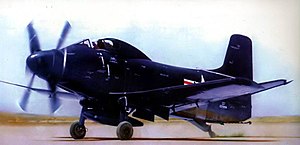Douglas A2D Skyshark: Difference between revisions
No edit summary |
|||
| Line 70: | Line 70: | ||
|power/mass main=0.27 hp/lb |
|power/mass main=0.27 hp/lb |
||
|power/mass alt=440 W/kg |
|power/mass alt=440 W/kg |
||
|guns=4 × [[20 mm caliber|20 mm]] (0.79 in) [[T31 cannon]] |
|guns= |
||
* 4 × [[20 mm caliber|20 mm]] (0.79 in) [[T31 cannon]] |
|||
* '''Other:''' |
* '''Other:''' |
||
** 5,500 lb (2,500 kg) on 11 external [[hardpoint]]s |
|||
}} |
}} |
||
Revision as of 05:23, 10 May 2009
| A2D Skyshark | |
|---|---|

| |
| Role | Attack aircraft |
| Manufacturer | Douglas Aircraft Company |
| First flight | 1950 |
| Status | Cancelled |
| Primary user | United States Navy |
| Number built | 12 (4 never flew) |
| Developed from | A-1 Skyraider |
The Douglas A2D Skyshark was a turboprop-powered attack aircraft built by the Douglas Aircraft Company for the United States Navy.
Design and development
In 1947 the Navy issued a letter of intent to Douglas Aircraft for a turboprop to be carrier-based. The need to operate from Casablanca-class escort carriers dictated the use of a turboprop instead of jet power.[1] The advantages of turboprop engines over piston was in power to weight ratio and the maximum power that could be practically generated. The advantage over jets was that a turboprop ran at near full RPM all the time, and thrust could be quickly generated by simply changing the propeller pitch. While resembling the AD Skyraider, the A2D was an entirely different airplane. Engine development problems delayed the first flight until May 1950. Allison failed to deliver a "production" engine until 1953, and while testing an XA2D with that engine, test pilot C. G. "Doc" Livingston pulled out of a dive and was surprised by a loud noise and pitch up. His windscreen was covered with oil and the chase pilot told Livingston that the propellers were gone. The gearbox had failed. Livingston successfully landed the airplane. By the summer of 1954, the A4D was ready to fly. The escort carriers were being mothballed, and time had run out for the troubled A2D program.[2] Due largely to the failure of the Allison T40 program to produce a reliable engine, the Skyshark never entered operational service.
Twelve Skysharks were built. Most were scrapped or destroyed in accidents, and only one is believed to have survived. The only known surviving Skyshark was restored for static display by Pacific Fighters at the airport at Idaho Falls, Idaho.{February 2005 issue of Air Classics} It was sighted there in August 2008,[citation needed] and is not in airworthy condition.
Specifications (XA2D-1)
Data from Encyclopedia of American Aircraft[3]
General characteristics
- Crew: 1
Performance
Armament
- Guns: * 4 × 20 mm (0.79 in) T31 cannon
- Other:
- 5,500 lb (2,500 kg) on 11 external hardpoints
See also
Related development
Aircraft of comparable role, configuration, and era
Related lists
References
Notes
- ^ Heinemann and Rausa 1980, p. 177.
- ^ Heinemann and Rausa 1980, p. 183.
- ^ Baugher, Joe (2001-10-24). "Douglas XA2D-1 Skyshark". Encyclopedia of American Aircraft.
Bibliography
- Heinemann, Edward, H. and Rausa, Rosario. Combat Aircraft Designer. London: Jane's Publishing Co., 1980. ISBN 0-7106-0040-2.
- Markgraf, Gerry. Douglas Skyshark, A2D Turbo-Prop Attack (Naval Fighters Number Forty-Three). Simi Valley, CA: Ginter Books, 1997. ISBN 0-942612-43-4.
